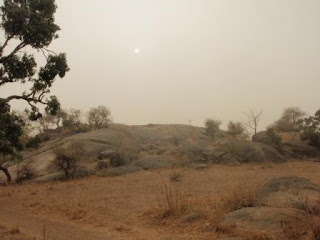





There have been many bulletins from Europe about the unusually harsh winter this year, including reports of prolonged freezing spells in Ireland. Cameroon has also experienced unusual weather and many people point to global warming as a cause.
Winter in the Far North of Cameroon runs from December to February. In December the weather was fairly typical, with the temperature very occasionally dropping below 20 degrees early in the morning and usually rising to the low 30s in the afternoon. By the time I went to work the temperature was usually in the low 20s, which I found very pleasant but which the local people found glacial. While I just wore a shirt, they usually had around five layers, including a heavy overcoat and a woolly hat. Some spoke of their hands freezing on their motorbike and many continued to wear their woolly hat even when the temperature climbed into the 30s. Most people suffered from colds and flu, often bringing on a bout of malaria.
In February the temperature climbed steadily and by mid-February it had reached 46 degrees, which is most unusual for that time of year. Happily I had to travel to the mountains of North West Cameroon for a couple of weeks and the climate there is much milder than in the Extreme North. It rained every day while we were there in what should have been their dry season. We had a similar experience when we visited Douala in January, where there was unseasonally heavy rain.
When I returned to the Far North at the beginning of March the temperature was 48 degrees and people told me that it had been even hotter while I was away. It felt as though we were in an oven which was getting ever hotter but then the weather took another unusual turn with the arrival of the harmattan. This is a wind which comes south from the Sahara and which contains huge clouds of dust, perhaps like the cloud currently passing over Ireland and Europe from the volcanic eruption in Iceland but evidently not as damaging to aircraft. With a weak harmattan everything is grey and the sun looks like the moon. This year it got to an intensity which people said they had never seen, the sun was blotted out, it was relatively dark all day and at times everything was in a yellow fog. The harmattan is very unhealthy, bringing on lots of respiratory problems, and it is very unpleasant since the dust gets into everything. It reminded me of the poniente which used to come north from the Sahara when I stayed in Tarifa in the south of Spain. People in Tarifa used to claim that they had the highest level of insanity in Europe and they blamed the poniente.
The harmattan had a positive effect in that it brought the temperature back down. It has passed now and the temperature drops to the low 30s in the morning and rises to the high 40s in the afternoon. Each day is hotter than the one before and the sun will be directly over us at midday around the end of April. There have been no storms yet so the electricity supply has not been cut much, and hence the water supply also (except that local vandals broke a pipe outside my house and it took six weeks to get my supply restored). My humidity guage stops at 20% and since the beginning of November it had only moved above that level for around three days in March when the temperature was soaring. However this week it has risen to around 50% and this has made the heat almost unbearble, compounded by a power and water failure in Maga.
When the first rains arrive there will be a dramatic transformation. Everything will begin to turn green, there will be loud choruses of frogs or toads at night, snakes will appear and mosquitos and hosts of other insects will proliferate.

No comments:
Post a Comment